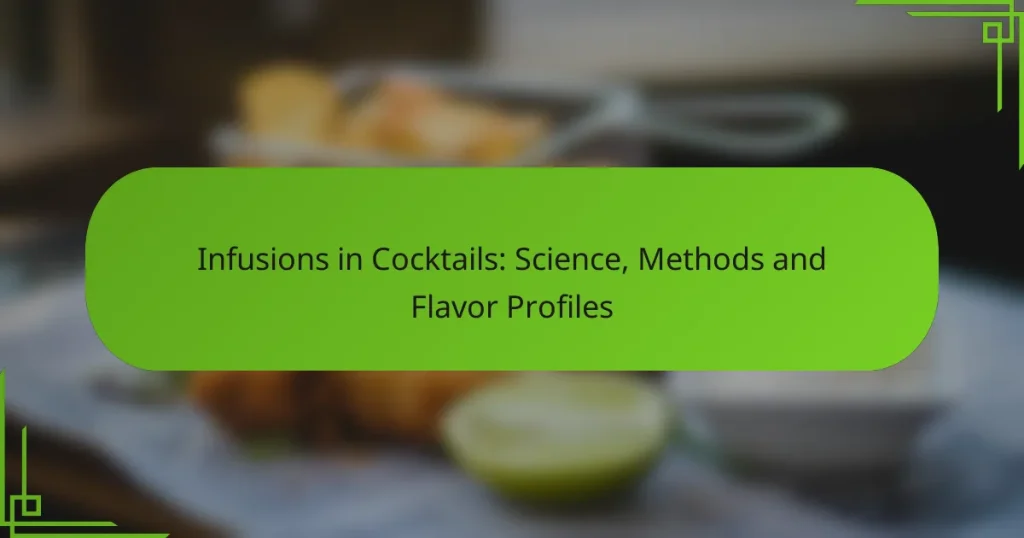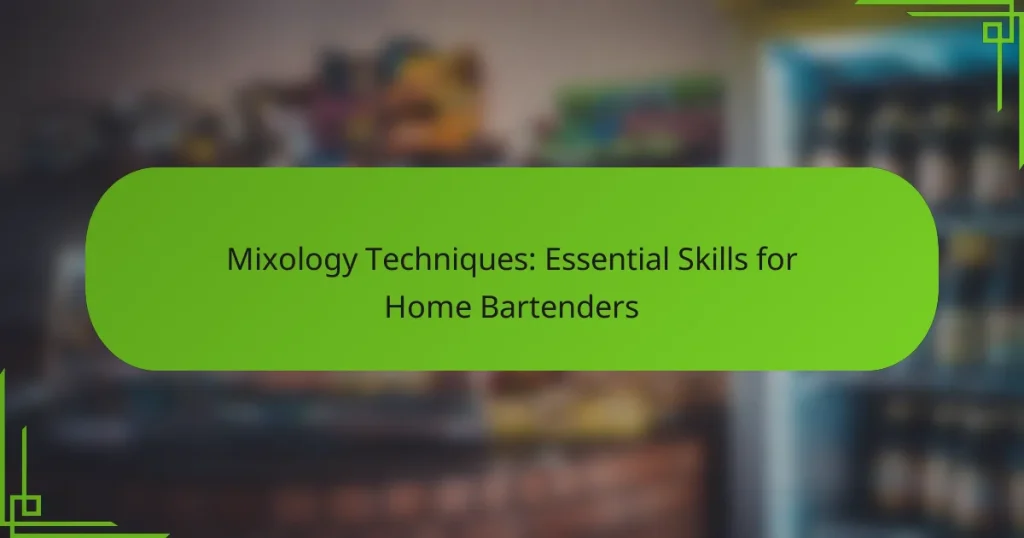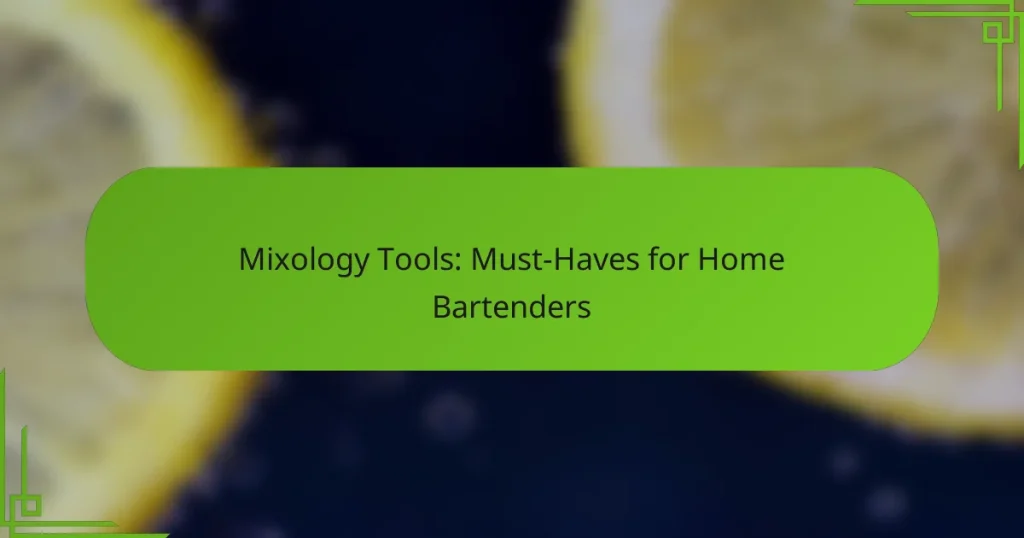Mastering expert mixology techniques is essential for bartenders aiming to create exceptional cocktails that delight customers. By blending creativity with a deep understanding of ingredients and utilizing the right tools, bartenders can ensure both quality and consistency in their drink offerings. Emphasizing unique ingredients and engaging with local producers further enhances the cocktail experience, fostering a sense of community and authenticity in every sip.
Infusions in Cocktails: Science, Methods and Flavor Profiles
Mixology Techniques: Essential Skills for Home Bartenders
Signature Cocktails: Creation, Personalization and Event Appeal
Mixology Tools: Must-Haves for Home Bartenders
Shaking vs. Stirring: Which Is Better and When to Use
Garnishing Techniques: Enhancing Cocktails with Style
What are expert mixology techniques for local bartenders?
Expert mixology techniques for local bartenders involve a combination of creativity, precision, and knowledge of ingredients. These techniques help bartenders craft unique drinks that appeal to customers while ensuring consistency and quality in every cocktail served.
Crafting signature cocktails
Creating signature cocktails allows bartenders to showcase their personal style and creativity. Start by identifying a theme or flavor profile that resonates with your bar’s identity, then experiment with different ingredients to develop a unique recipe. Aim for balance in flavors, and consider using local spirits or seasonal ingredients to enhance the drink’s appeal.
Once you have a signature cocktail, promote it through your menu and social media to attract customers. Regularly update your offerings to keep the selection fresh and exciting.
Utilizing fresh ingredients
Using fresh ingredients is crucial for enhancing the flavor and quality of cocktails. Fresh fruits, herbs, and spices can elevate a drink, making it more vibrant and appealing. Whenever possible, source local produce to support nearby farmers and ensure the highest quality.
Consider incorporating fresh juices instead of pre-packaged options, as they provide a brighter taste. Additionally, infuse spirits with fresh herbs or fruits for a unique twist on classic cocktails.
Mastering classic recipes
Mastering classic cocktail recipes is essential for any skilled bartender. Familiarize yourself with foundational drinks like the Martini, Old Fashioned, and Mojito, as they form the basis for many variations. Understanding the proportions and techniques used in these classics will allow you to innovate while maintaining quality.
Practice the techniques involved, such as shaking, stirring, and muddling, to ensure consistency in your drinks. This knowledge also helps in creating variations that appeal to different tastes while respecting the original recipe.
Implementing advanced garnishing
Advanced garnishing techniques can enhance the visual appeal and aroma of cocktails. Experiment with various garnishes, such as edible flowers, flavored foams, or intricate fruit carvings, to create a memorable presentation. A well-executed garnish not only beautifies the drink but also adds an extra layer of flavor.
Keep in mind that garnishes should complement the cocktail’s flavor profile. Avoid overly complicated designs that may distract from the drink itself. Simple, elegant garnishes often have the greatest impact.
Understanding flavor profiles
Understanding flavor profiles is key to creating balanced cocktails. Familiarize yourself with the basic taste categories: sweet, sour, bitter, salty, and umami. Each ingredient contributes to these profiles, and knowing how they interact will help you craft harmonious drinks.
When developing a cocktail, aim for a balance of flavors. For example, if a drink is overly sweet, consider adding acidity through citrus or bitterness through a liqueur. Experiment with different combinations to discover new and exciting flavor pairings that resonate with your clientele.
How can local bars enhance their cocktail menus?
Local bars can enhance their cocktail menus by focusing on unique ingredients, collaborating with nearby producers, and actively engaging with customer preferences. These strategies not only elevate the drink offerings but also create a sense of community and authenticity.
Seasonal ingredient sourcing
Seasonal ingredient sourcing involves using fresh, locally available produce to create cocktails that reflect the time of year. This approach not only supports local farmers but also ensures that drinks are vibrant and flavorful. For example, using summer fruits like peaches or berries can add a refreshing twist to cocktails.
Bars should consider establishing relationships with local farmers’ markets or community-supported agriculture (CSA) programs to secure the best seasonal ingredients. Regularly updating the menu to reflect these changes keeps the offerings exciting and encourages repeat visits.
Collaborating with local distilleries
Collaborating with local distilleries allows bars to feature unique spirits that are not widely available. This partnership can lead to exclusive cocktails that highlight the distinct flavors of local liquors, creating a unique selling point for the bar. For instance, a bar might create a signature cocktail using a locally distilled gin infused with regional botanicals.
Bars should reach out to distilleries for tastings and events, which can foster a sense of community and attract customers interested in local products. Such collaborations can also include co-hosted events, where patrons can learn about the distilling process while enjoying crafted cocktails.
Incorporating customer feedback
Incorporating customer feedback is essential for tailoring cocktail menus to meet patrons’ tastes. Bars can gather insights through comment cards, social media polls, or direct conversations with customers. This feedback can guide menu adjustments and new cocktail creations that resonate with the clientele.
To effectively utilize feedback, bars should regularly review customer suggestions and track popular items. Implementing a rotating feature cocktail based on customer votes can create engagement and excitement, making patrons feel valued and more likely to return.
What are the essential tools for expert mixology?
Expert mixology requires a set of essential tools that enhance the cocktail-making process. These tools help ensure precision, consistency, and creativity in crafting drinks.
Shakers and strainers
Shakers are vital for mixing ingredients thoroughly, incorporating air, and chilling cocktails. The two main types are the Boston shaker, which consists of a metal tin and a glass, and the cobbler shaker, which has a built-in strainer. Each type has its advantages, with the Boston shaker being favored for its larger capacity and ease of cleaning.
Strainers are used to separate the liquid from the ice and solid ingredients after shaking. The most common types are the Hawthorne strainer, which features a spring for better filtration, and the fine mesh strainer, ideal for achieving a smooth pour. Always ensure your strainer fits your shaker to avoid spills.
Jiggers and muddlers
Jiggers are essential for measuring spirits and mixers accurately, ensuring balanced cocktails. They typically come in double-sided designs, with one side measuring 1 ounce and the other 0.5 ounces, allowing for quick and precise pours. Using a jigger helps maintain consistency across drinks.
Muddlers are used to crush herbs, fruits, or spices to release their flavors. A good muddler should have a flat end for effective muddling without damaging the glass. Avoid excessive force, as this can lead to bitterness from over-muddled ingredients.
Mixing glasses and bar spoons
Mixing glasses are used for cocktails that require stirring rather than shaking. These glasses are typically made of glass or crystal and allow for easy observation of the drink’s clarity. When using a mixing glass, fill it with ice before adding the ingredients to chill them effectively.
Bar spoons are long-handled utensils designed for stirring cocktails in mixing glasses. They often feature a twisted handle for better grip and a small scoop at the end for measuring ingredients. When stirring, aim for a gentle motion to combine flavors without diluting the drink too quickly.
How do expert mixologists ensure consistency?
Expert mixologists ensure consistency by adhering to standardized recipes, conducting regular staff training, and implementing quality control measures. These practices help maintain the same flavor profiles and presentation across different shifts and locations.
Standardized recipes
Standardized recipes are essential for achieving consistency in cocktails. They provide precise measurements for each ingredient, ensuring that every drink tastes the same regardless of who prepares it. For example, a recipe might specify 1.5 ounces of gin, 0.75 ounces of vermouth, and a dash of bitters for a classic martini.
Using a recipe card or digital system can help bartenders quickly reference the correct proportions. It’s also beneficial to periodically review and update recipes based on seasonal ingredient availability or customer feedback.
Regular staff training
Regular staff training is crucial for maintaining consistency in drink preparation. Training sessions should cover the proper techniques for mixing, shaking, and garnishing cocktails, as well as the importance of following recipes accurately. New hires should shadow experienced bartenders to learn best practices.
Additionally, ongoing training can introduce staff to new cocktails or seasonal specials, ensuring that everyone is on the same page. This can be done through monthly workshops or tastings that reinforce the standards expected in the bar.
Quality control measures
Implementing quality control measures helps ensure that every cocktail meets the establishment’s standards. This can include regular taste tests, where staff sample drinks to confirm flavor consistency. Managers should also monitor inventory to ensure that high-quality ingredients are always available.
Another effective strategy is to establish a feedback loop with customers. Encouraging patrons to share their experiences can provide valuable insights into the consistency of drinks served. Addressing any discrepancies promptly can help maintain a high standard of quality.
What are the best practices for cocktail presentation?
The best practices for cocktail presentation focus on enhancing the visual appeal and overall experience of the drink. Key elements include selecting appropriate glassware, using effective garnish techniques, and ensuring the right serving temperature.
Glassware selection
Choosing the right glassware is crucial for cocktail presentation. Different cocktails require specific types of glasses to enhance their flavors and visual appeal. For example, a martini is best served in a classic martini glass, while a whiskey sour is typically presented in a rocks glass.
Consider the size and shape of the glass, as well as its ability to showcase the drink’s color and garnishes. Clear glasses allow for better visibility of layered drinks, while colored or textured glasses can add an artistic touch.
Garnish techniques
Garnishes not only add flavor but also elevate the visual presentation of cocktails. Common techniques include using fresh herbs, citrus twists, or edible flowers. A well-placed garnish can create a focal point that draws attention to the drink.
When garnishing, ensure that the elements complement the cocktail’s flavor profile. For instance, a sprig of mint works well with mojitos, while a lemon twist enhances the aroma of gin-based cocktails.
Serving temperature considerations
Serving temperature significantly impacts the enjoyment of cocktails. Most cocktails are best served chilled, which can be achieved by using ice or pre-chilling the glassware. For example, a classic margarita should be served cold to maintain its refreshing qualities.
Be mindful of the balance between temperature and dilution. Over-ice can lead to a watered-down drink, so consider using larger ice cubes or spheres that melt slower. Aim for a serving temperature that enhances the drink’s characteristics without compromising its integrity.
How can mixologists adapt to local tastes?
Mixologists can adapt to local tastes by understanding regional preferences and incorporating local ingredients into their cocktails. This approach not only enhances the drink’s appeal but also fosters a connection with the community.
Researching regional preferences
Understanding regional preferences involves studying the local culture, traditions, and popular flavors. Mixologists should explore local markets, attend food festivals, and engage with residents to gain insights into what flavors are favored in the area.
Consider creating a survey or informal focus groups to gather feedback on local favorites. This can help identify specific ingredients or cocktail styles that resonate with the community, ensuring the drinks offered align with local tastes.
Additionally, examining the popularity of certain spirits or mixers in the region can provide clues. For example, if a particular type of rum is favored in a coastal area, incorporating it into signature cocktails can enhance customer satisfaction.






